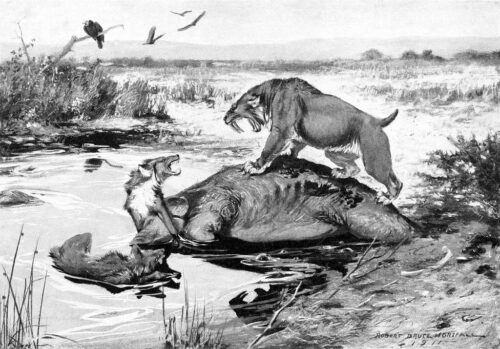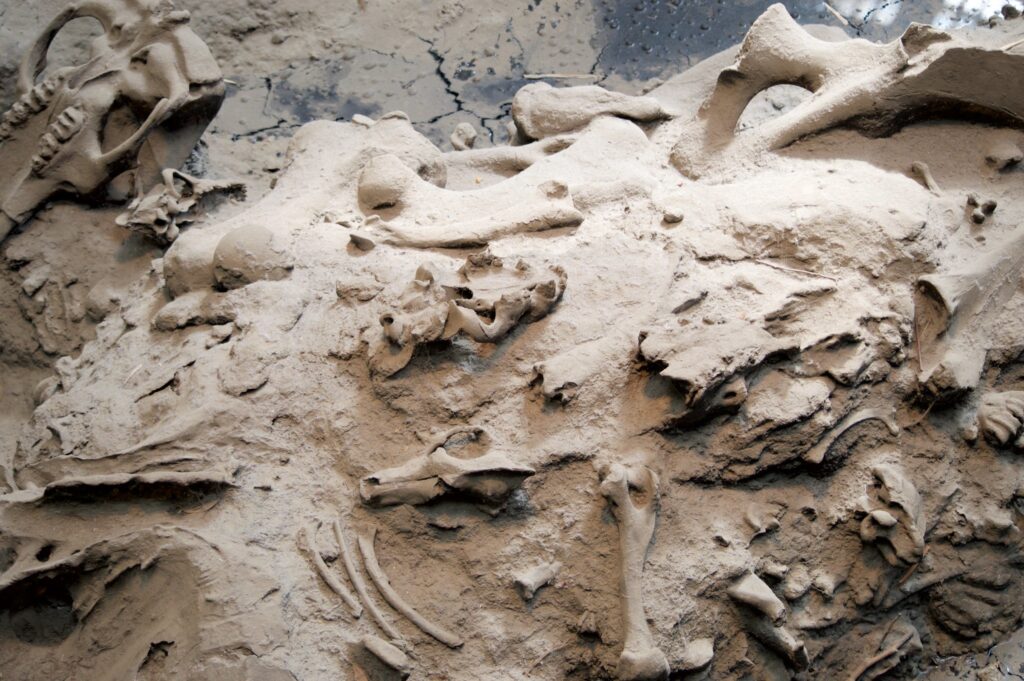
Around 10,000 years ago, two-thirds of Earth’s large mammals blipped out of existence. Mammoths, mastodons, sabertoothed cats, and many other species from all over the world went extinct. Despite investigating many possible causes, biologists have yet to find a smoking gun revealing the culprit behind the disappearances. But that doesn’t necessarily mean that we are missing something. Extinction can be, well … complicated. Perhaps we haven’t been able to identify a single main trigger for the extinctions because several causes acted together. A new study takes this possibility seriously and untangles the interacting factors behind large mammal extinctions in Southern California at the end of the last Ice Age.
Where's the evolution?
The investigation took advantage of the fossil record provided by Los Angeles’ La Brea Tar Pits. Over the last 50,000 years, vast numbers of animals have wandered into these pools of molten, bubbling asphalt and never made it out again. In a boon for paleontologists, the pits preserve the bones of these animals in conditions that make it possible to date them precisely.

The many hundreds of thousands of fossils preserved at La Brea also help solve a common challenge for paleontologists studying extinction: how do we know if a species missing from the fossil record actually went extinct or if it survived but didn’t leave behind fossils in the rocks being studied? The tar pits were such an effective trap for animals and so reliable about preserving them that paleontologists can be confident that a lack of fossils is closely tied to local extinction. So if, for example, the youngest camel fossils in the tar pits are about 13,700 years old, we can be confident that the last camels living in Southern California actually went extinct shortly after that date.
The researchers behind the new study dated 172 fossils from La Brea, including sabertoothed cats, dire wolves, and camels, to figure out when each species disappeared from the local landscape. The team then compared these “last seen” dates to the timing of other changes going on around the same time to tease out which factors might have triggered the extinctions.
The scientists figured out the timing of the extinctions by dating samples from a dense fossil record, but how did they figure out what else might have been going on in the area so long ago? One line of evidence they consulted came from nearby Lake Elsinore. The sediment at its bottom was deposited layer by layer over time, collecting detritus from the last 30,000 years of Southern California’s history in an orderly fashion. By studying the makeup of these dated sediment layers, we can learn a lot about the local environment, including its history relating to:
- Local plant types – Ancient pollen preserved in the sediments can be used to figure out which plant types were common in the environment at different times.
- Air temperature – In response to temperature changes, certain bacteria make subtle changes in chemicals that comprise their outer membranes. These chemical structures reliably indicate the temperatures that the bacteria experienced. Such bacteria-produced chemicals are preserved in the sediments of Lake Elsinore and can be used to understand how air temperature changed over time.
- Rain and snow – More precipitation means more water running into streams and washing sand downstream into the lake. Scientists use the amount of sand in different sediment layers to figure out the timing of dry and wet periods in the region.
- Wildfires – Wildfires lead to ash in the air, which makes its way into streams and lakes, accumulating in the sediment. As with sand, the amount of charcoal in different sediment layers indicates how common large fires were at different times.
The researchers were also interested in any role that humans might have played in the extinctions, so they constructed a record of human presence in North America based on archeological data.
Now, the team had multiple timelines charting how large mammal and human populations rose and fell in the area, as well as how the climate and landscape changed. And these timelines seemed to line up in meaningful ways. Most notably, during one brief 400-year period, Southern California rapidly shifted from a forest ecosystem with many large mammal species to an unforested, fire-prone region with no large mammals.
What happened? To help figure it out, the team used mathematical modeling to see how much changes in one timeline predicted a later change in another timeline. Unsurprisingly, they found that increases in temperature and decreases in rainfall lead to an increase in wildfires. And they found that human population growth leads to fewer herbivores and more fires.
Taken together, the data tell a story of rapid environmental change in which humans play a central role. In Southern California at the end of the last Ice Age, as the region warmed and entered a drought, forests were replaced by other vegetation. At the same time, human populations, which depended on hunting large mammals, were on the rise. In addition, our fires sometimes burned out of control, further altering the dry, stressed landscape, ultimately resulting in the extinction of large mammals.
Sound familiar? Today, human-produced greenhouse gases are rapidly warming Earth. As the climate changes, many regions are experiencing deep droughts. In the last five years, massive wildfires have ravaged Maui, Canada, Greece, California, and Australia. We face an extinction crisis massive in scale. The similarities between today’s environmental challenges and those that rocked Earth at the end of the last Ice Age are clear. To protect Earth’s biodiversity from the worst outcomes of this perfect storm of global change, we will need to study the fossil record of plants and animals to understand the complex, interacting factors that lead to extinction, both in the past and today. And then of course, comes the hard part: acting on that knowledge.
Primary literature:
- O’Keefe, F. R., Dunn, R. E., Weitzel, E. M., Waters, M. R., Martinez, L. N., Binder, W. J., …and Lindsey, E. L. (2023). Pre-Younger Dryas megafaunal extirpation at Rancho La Brea linked to fire-driven state shift. Science. 381: eabo3594 Read it »
News articles:
- A video introducing the research from one of the study’s authors, Emily Lindsey
- A press release from UCLA
- A detailed explanation of the research from the Natural History Museum of Los Angeles County
Understanding Evolution resources:
- Describe two traits that make the fossils of the La Brea Tar Pits particularly useful for scientists studying extinction.
- Imagine that a paleontologist studying a rock formation finds that a particular fish species is found in rock layers dated up to 5.2 million years ago, but the fish isn’t found in younger strata. From this evidence, can we conclude that the fish went extinct 5.2 million years ago? Why or why not? Explain your reasoning.
- The scientists behind the study described here used data from the bottom sediments of Lake Elsinore.
- What sort of information did they get from these sediments?
- Why was this information important in figuring out what caused the extinction of the local large mammals?
- In your own words, describe at least three changes that seem to have contributed to the extinction of large mammals at La Brea.
- Compare any recent environmental changes you can observe in your local community (e.g., wildfire smoke, drought, land use) to those operating at La Brea just before the extinctions.
- Are they similar or different and in what ways?
- Do you think that any of the changes you can observe locally might contribute to extinctions? Explain your reasoning.
- Teach about interpreting fossil evidence: In this activity for grades 3-12, students play the roles of paleontologists on a dig. They “unearth” a few fossils at a time and attempt to reconstruct the animal the fossils represent.
- Teach about megafaunal extinction: In this comic for grades 6 and up, students follow the investigation of scientists Maria and Miguel as they solve a paleontological mystery. About 11,000 years ago, more than 80% of the large animal species in South America went extinct. Why did it happen? (Available in English, Spanish, and Portuguese)
- Teach about extinction and data interpretation: In this article (and the linked assignments and student readings) for the high school and college levels, students examine and interpret data that Melissa Kemp and Liz Hadly use to study extinction bias in Caribbean lizards.
- O’Keefe, F. R., Dunn, R. E., Weitzel, E. M., Waters, M. R., Martinez, L. N., Binder, W. J., …and Lindsey, E. L. (2023). Pre-Younger Dryas megafaunal extirpation at Rancho La Brea linked to fire-driven state shift. Science. 381: eabo3594.
